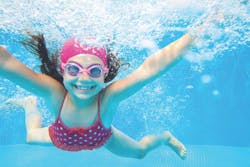Standard Update Sets Chloramine Reduction Testing & Safety Flooring Criteria
About the author:
Theresa Bellish is general manager of water systems for NSF International. Bellish can be reached at [email protected].
With more than 300 million visits to recreational water sites each year, it is no surprise that swimming is one of America’s most popular activities. Swimming is fun for people of all ages and a great way to keep healthy.
According to the Pool and Hot Tub Alliance, there are 309,000 public pools and other types of aquatic venues in the U.S., so it is important that all aspects of these facilities are operated to the highest safety standards.
Updates Sets Chloramine Reduction Testing & Safety Flooring Criteria
NSF/ANSI Standard 50: Equipment and Chemicals for Swimming Pools, Spas, Hot Tubs and Other Recreational Water Facilities is required by most commercial swimming pool codes. Recent additions are designed to protect the millions of people who enjoy these venues year-round by establishing a new validation method for chloramine reduction and flooring safety criteria.
Though designed for fun, indoor and outdoor swimming pools, water parks, spas and other types of recreational water facilities can pose serious health threats if not managed properly, according to the U.S. Centers for Disease Control and Prevention (CDC). The CDC has published health and safe swimming toolkits, and in 2014 adopted the first Model Aquatic Health Code (MAHC) outlining design, construction and management of public aquatic facilities.
Many swimming and pool-related illnesses or injuries are related to improper use of pool treatment chemicals. The CDC reports between 3,000 and 5,000 emergency department visits each year are for injuries related to pool chemicals.
The new version of NSF/ANSI Standard 50 includes a section that provides a validation method for chloramine reduction, one of the biggest issues in the pool and recreational water industry.
This new test method is important because the symptoms that swimmers attribute to over-chlorination—such as an overbearing smell, red eyes, irritated mucous membranes and respiratory irritation—are caused by chloramines.
What Are Chloramines?
Chloramines form when chlorine, which is used to kill germs, bonds to sweat, urine and other human waste that it normally is meant to fight against in pools. Chloramines build up in the water, reducing the disinfecting power in pools, and then
off-gas into the air. They are heavier than air, which means that when they off-gas from the water they sit just above the surface of the pool. This is particularly bothersome for indoor facilities.
As a result, what is created is not necessarily over-chlorination as some might think because of the strong smell, but not enough free chlorine, which is the active disinfectant form of chlorine to kill microorganisms and germs in the pool. Additionally, when indoor facilities’ ventilation does not properly exhaust the chloramines, the recirculated chloramine-filled air over the water prevents additional chloramines from escaping the pool, the CDC reports. That build-up of chloramines in the water can cause negative health effects to swimmers.
A water conditioning device by Pentair specializing in pool and spa equipment was the first to be certified against this new validation method.
Safe Flooring at Splash Pads
Additionally, NSF/ANSI Standard 50 establishes minimum criteria for flooring at interactive water play venues.
With the explosion of splash pads across the country, this update to the standard is intended to improve safety by addressing health effects, slip resistance, impact attenuation, ultraviolet light and chemical resistance, imperviousness, clean-ability and durability of flooring surfaces at splash pads and other types of recreational pool and water venues.
Pool operators who use flooring certified to this new requirement can be assured that their venue meets the highest public safety standards for their guests. The response to changes in the standard has been positive within the recreation water industry.
Safety flooring tiles from one manufacturer, Life Floor, have been certified to the new section of the standard, and other manufacturers have expressed interest.
NSF International has worked for decades with key industry stakeholders to make pools, spas and recreational water products safer, and in 1977 facilitated the development of NSF/ANSI Standard 50 to establish minimum requirements for virtually every component at public and private recreational water facilities and spas.
In addition to pool treatment chemicals, this standard sets safety criteria for pumps, drain covers, filters, suction fittings, grates, ozone and ultraviolet systems, and water test devices. Specifically, the standard addresses material health effects, corrosion resistance, performance, disinfection efficacy, durability testing, design and construction, marking and user instructions.
The NSF/ANSI 50 Joint Committee—an impartial consensus-based group comprised of a balanced number of representatives from regulatory, industry, academic and consumer groups—began developing the new section of the standard to address safety surfacing for interactive water play venues in 2016.
